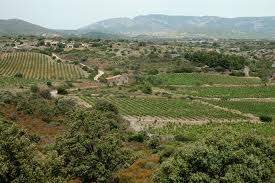Contrary to the what most people think there is very little natural about the garrigue that covers the hills of the Aude and the Languedoc.
It is very much the product of the agricultural development of the land. The history of this ecology can be traced back over 4500 years but the last 60-70 years have been the most dramatic. The garrigue is very much a product of man’s over exploitation of the dry Mediterranean landscape.
4500 years ago the migration from the Middle East brought tribes with horses, barley, sheep, and skills in copper working. The land they found was a continual forest of white and green oaks. They clearer spaces for cultivation and used wood and charcoal for their heating and metal work. The horses gave them access to the highest forests and the sheep ate the smaller plants under the trees. 2000 years later the Romans arrived and cleared huge spaces for the great Via Domitienne and their towns (Oppida) and farms, much of which was later run down by the all conquering Wisigoths. Around 1000 AD the religious orders of Catholic monks cleared much of the coastal plains and foothills. In this period the population doubled, as the monks introduced the great mainstays of Languedocean agriculture, olives, vines and wheat. Indeed the history of most of today’s villages and small towns can be traced back to around the 11th century. The great forests were clearer, the plains filled with wheat fields, the hill sides terraced and planted with predominately olives and a few vines, sheep and goats roamed the remaining wild areas during the winters and were moved to the Pyrenean pastures during summer. During the 17th and 18 century textile industry in Carcassonne, and a less extent Limoux, supported 500,000 sheep before the British naval blockade during the Napoleonic wars cut off the industry from it’s Middle East markets.
The French Revolution removed the aristocracy and the remaining wild hunting areas were cut down by charcoal burners and shepherds. The agricultural pattern continued through to the 19th century, when the improved communications provided by firstly the Canal du Midi and then by steam power made the commercial exploitation of vines much more profitable. The impact of the French Revolutions is explored in fascinating detail by Peter McPhee in his Revolution and Environment in Southern France.
Between Carcassonne and Toulouse the great wheat fields grew and provided the wealth for Toulouse, Castelnaudry and Carcassonne. Between 1820 and 1860 the population doubled on the back of this wheat and wine based wealth.
It was however the 1950s and 1960s which really formed the garrigue as we now know it.
Five main factors totally transformed the Languedoc:
» In 1953 the first tractors arrived in the Languedoc, this broke the reliance on horse power, a by product was that tractors could not access the steep slopes of the hills that previously could be accessed by foot and horse, thus leaving isolated and inaccessible land uncultivated.
» The replacement of gas with petrol products removed the demand for charcoal and went a major way to slow down the high forest clearing.
» The great frost of 1956 which killed off many of the olives which covered the hillsides, most were never replanted.
» The common agricultural market which opened competition from British, Australian and New Zealand lamb and effectively destroyed the Languedocean sheep industry.
» In 1954 myxomatosis hit the Languedoc, the rabbits that had been introduced by the Romans and whose abundance and low cost had made them a mainstay of rural cuisine were wiped out, 99% of the rabbit population died.
Added to these push factors was the ever growing demand from a booming French industry, these were the Golden Years of the great factories. Faced with an ever harder life in the countryside and profitable work in the cities and towns the countryside of the Languedoc emptied of people, over a million hectares of agricultural land fell out of use in France, huge swathes of it in the Languedoc.
No longer roamed by hungry sheep and rabbits, cleared by charcoal burners, and cultivated by small holder farmers the garrigue as we now know it recovered the empty spaces of the Languedoc hillside.
However with 1,500 new arrivals every month in the Languedoc, 18,000 a year at present rates the open spaces face a new threat. Each family of three it is estimated need around 1500 square metres of land, this includes not just the house but also the public serves and infrastructure needed to support them, a 1000 hectares per year are being lost to development. The great difference however is that people need water and so tend to concentrate around existing urban centres, the garrigue on the other hand can survive on very little.


super interesting! thanks a lot!